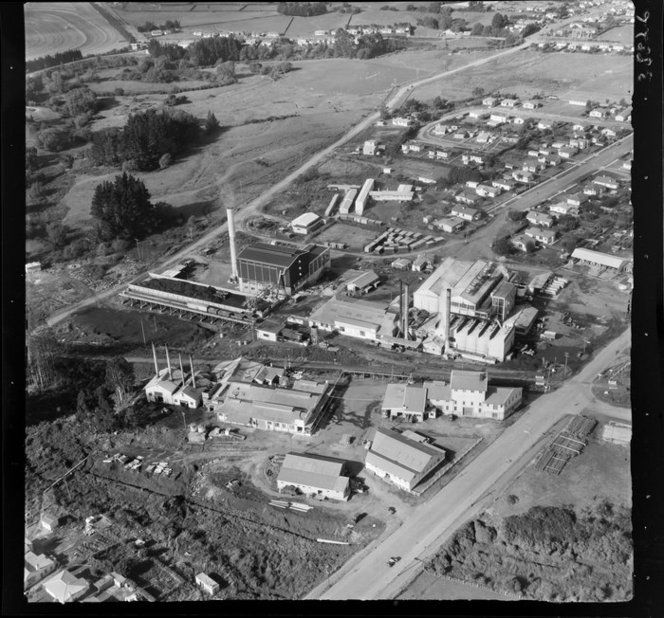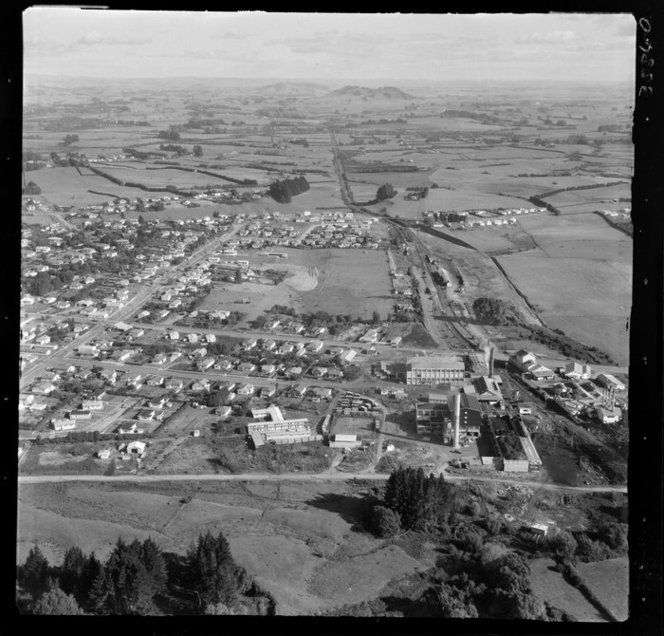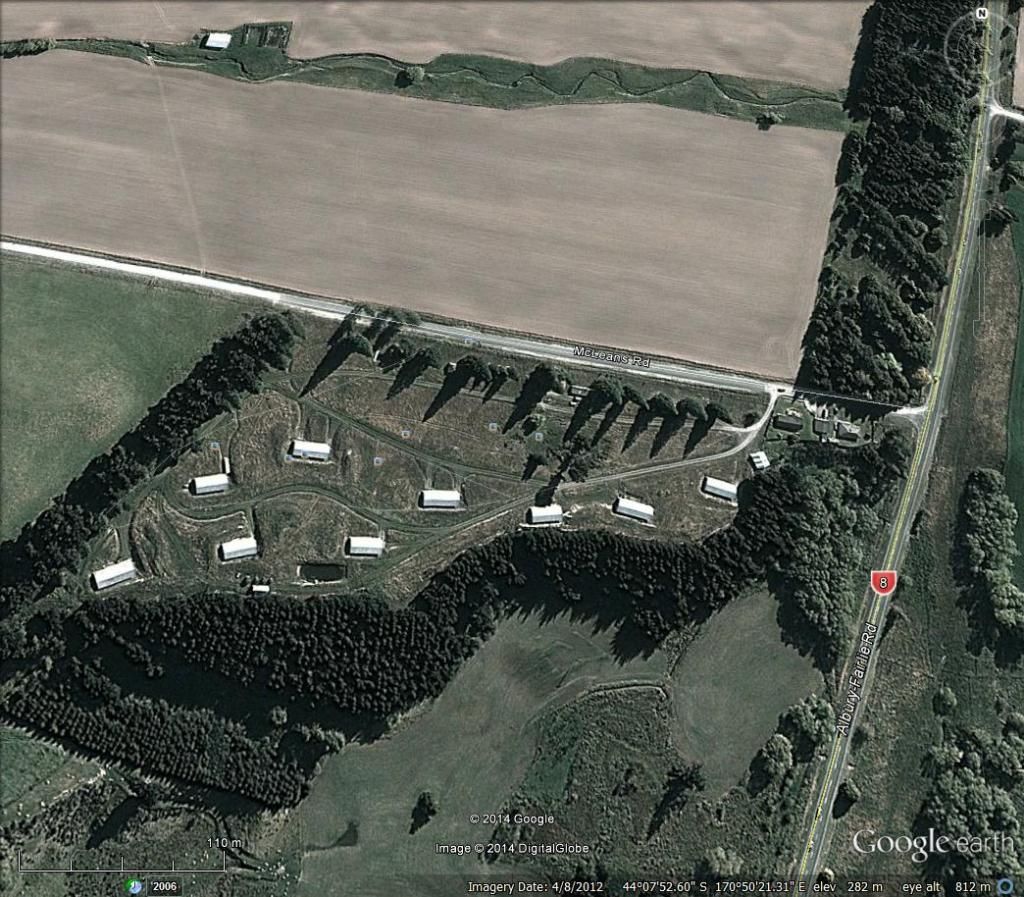|
|
Post by Dave Homewood on Oct 27, 2014 11:51:04 GMT 12
|
|
|
|
Post by suthg on Oct 27, 2014 12:18:01 GMT 12
Ok perhaps it was that photo after all.  |
|
|
|
Post by pjw4118 on Oct 29, 2014 9:41:40 GMT 12
Here is a PWD photo of Mungaroa 1943 and one of Te Awamutu. The stores building appears to be beside the dairy company and railway.    |
|
|
|
Post by Dave Homewood on Oct 29, 2014 15:00:52 GMT 12
So which bits are the RNZAF Depot? Any ideas? Is that the Air Force buildings in the foreground? I wonder where the accommodation for all the RNZAF and WAAF staff was. |
|
|
|
Post by camtech on Oct 29, 2014 15:26:13 GMT 12
Mmmm - dragging up some memories.
My late father in law used to deliver and pick up from the "air force store" when he was an owner-driver back in the 70's/80's. I went with him a couple of times, but can't get the location in my head related to the photo.
He was a driver in the air force, based at Te Rapa 49/50ish, so knew about the stores at Te Awamutu.
|
|
|
|
Post by pjw4118 on Oct 29, 2014 16:36:22 GMT 12
My guess is in the second photo of the dairy/RNZAF Store ( dated 1947) the store is directly above the chimney. Dave in the photo you reposted , its taken from 90 degrees or more away ( and is dated 1950s) the stores building is just above the right hand thick chimney that looks like a rocket.
I assume that the dairy company took the building over post war.
|
|
|
|
Post by Bruce on Oct 29, 2014 16:41:47 GMT 12
So which bits are the RNZAF Depot? Any ideas? Is that the Air Force buildings in the foreground? I wonder where the accommodation for all the RNZAF and WAAF staff was. None of those bits are the depot - its across the stream to the left (or at least the main bits were) |
|
|
|
Post by Bruce on Oct 29, 2014 16:49:42 GMT 12
Picture below is from Google earth. the arrow points to the remaining stores building at the time of the photo - I beleive this has gone now. Above it is where the railway preservation group had their sidings. The big building with the water problem would be under the big modern Fonterra Coolstore. I understand this area is still referred to sometimes as the "Air Force sidings"  |
|
|
|
Post by eieio on Oct 29, 2014 18:03:16 GMT 12
Mr Cook is bang on, in the google pic on the near side [mid right]of the rail line are Fonterra stores ,formerly the "Lotus" Te Awamutu Co operative Dairy Co. site.[Demolished about 1985 and the store built. There long before 1945 ,top side of the rail line is NZ Co-op Dairy Co buildings ,now Fonterra ,again a prewar industry .Note the conveyer bridge between the Production and the storage.
|
|
|
|
Post by pjw4118 on Oct 30, 2014 8:27:52 GMT 12
Thats great detail thanks
|
|
|
|
Post by pjw4118 on Oct 31, 2014 10:49:47 GMT 12
Bruce and Eicio? I have these two, one PWB the other Whites. Is this the RNZAF store?   |
|
|
|
Post by Bruce on Oct 31, 2014 11:54:34 GMT 12
Yep! those are the stores in the centre bottom of each pic. In the last one you can see the building that is in Google earth. In the first one it looks like construction in progress - with what appears to be a lot of standing water! the site sits on a river terrace below the neighbouring racecourse. Ive been there to see the railway group when it was operating, and there was a lot of water around then too. Obviously didnt drain well - which makes it an odd place for a stores depot!
|
|
|
|
Post by pjw4118 on Oct 31, 2014 16:30:29 GMT 12
Thanks Bruce, I can now file it in its proper place.
|
|
|
|
Post by Dave Homewood on Oct 31, 2014 18:00:07 GMT 12
They liked to select swampy ground for the Air Force as it was cheap and unwanted. Hence the reason Whenuapai and Ohakea are where they are.
|
|
|
|
Post by davidd on Nov 1, 2014 11:48:53 GMT 12
Ardmore also springs to mind - its original runways did not last long, particularly with big heavy Corsairs thumping down on them with monotonous regularity. Conversely, at Te Pirita, the engineers reckoned the water table was about 40 feet down, but it was never put to the test. The engineers were confident that B-17s and B-24s would never have any trouble there, even though it was planned that these aircraft would be widely dispersed throughout the surrounding pine plantations, and little in the way of proper taxiways were considered necessary. Of course Te Pirita was only ever intended for "occasional" use as a dispersal field in case of Japanese carrier raids on our well-known "coastal" airfields (including Ohakea).
David D
|
|
|
|
Post by Dave Homewood on Nov 1, 2014 13:57:51 GMT 12
The land at Ohakea was apparently originally purchased by the Government to use as an airship base as they planned to have huge airships travelling there all the way from the UK. I guess it was flat and very cheap but surely the wind factor there would have made it very unsuited to tethering and mooring airships! Bean counters at work again.
|
|
|
|
Post by davidd on Nov 2, 2014 9:17:24 GMT 12
Thought the extract below from the Aerodrome Services Branch of the Public Works Department war history (compiled by L Clifton, September 1947, pages 34 - 35) might be of some interest to Board members.
"RNZAF Stores Depots - Te Rapa, Te Awamutu, Mangaroa, Weedons.
"On 29th June 1942, the construction of these stores was approved, the initial stage being:-
25,000 square feet at Te Rapa, plus 75,000 sq ft at Winter Show Building and Ebbetts Garage.
50,000 sq ft at Te Awamutu.
25,000 sq ft at Mangaroa.
25,000 sq ft at Weedons.
"Contracts were let for the erections of the buildings in July and work was started in August. By the end of the year most of the initial programme had been completed and additional buildings had been started. Building was continued throughout the year 1943.
"The stores were mostly of the "Adams" type, single storied but with mezzanine floors, and fitted with mobile cranes. They varied in size from 90 ft by 220 ft to 60 ft by 330 feet. In the transit blocks there were overhead electric cranes with spans of 90 feet. Pyrtotechnics, oils and dopes were stored separately in standard 23 by 20 ft huts with concrete floors. There were four of these huts to each stores depot. Sprinkler systems were installed in all depots except Mangaroa. The personnel accommodation necessary was considerable. At Te Rapa for example, there were 26 x 20 ft and 30 ft by 8 ft huts, 4 x 20 ft by 48 ft buildings, a number of smaller huts, together with ablutions. latrines, etc. Accommodation for WAAF's was provided.
"In their final form the details of the four depots were as follows:-
No. 1 SD (Te Rapa). Establishment 12 officers, 176 ORs, storage area 150,000 sq ft, comprises 12 stores of varying sizes at Te Rapa plus one bulk store at Otahuhu, Auckland.
No. 2 SD (Mangaroa). Establishment 12 officers, 217 ORs, storage area 380,000 sq ft, comprises 17 stores of varying sizes, 8 at Mangaroa, 8 at Gracefield, and one at Rongotai.
No. 3 SD (Weedons). Establishment 8 officers, 127 ORs, storage area 121,000 sq ft, comprises 17 stores of varying sizes at Weedons, plus 1.5 hangars at Harewood
No. 4 SD (Te Awamutu). Establishment 6 officers, 120 ORs, storage area 77,000 sq ft, comprises 10 stores of varying sizes at Te Awamutu."
This gives a good idea of the size of each establisment, and also shows that quite apart from the prime site, all but one of these depots also controlled other buildings many miles away. Even I had forgotten that 2 SD for instance still had a store at Rongotai as well as eight more at Gracefield, and 3 SD had hangars at Harewood. Ii is possible that the Gracefild stores were commercial buildings taken over for the duration of the war, but as many of these bulidings were retained for considerable periods following the war I could well be mistaken in this belief, and these may have been the new construction undertaken "throughout the year 1943".
Also noticeable that Te Rapa and Mangaroa were considerably larger units (by floor space) with far larger personnel establishments and greater dispersal of buildings than the more compact Weedons and Te Awamutu depots. There is also no mention in this source that the Te Awamutu store was originally intended for the Americans, but this is very briefly covered in J M S Ross (pages 121, 284).
David D
|
|
|
|
Post by davidd on Nov 2, 2014 10:15:14 GMT 12
Dave H,
The site for the airship mooring in the Manawatu was chosen, so far as I know, by "airship experts" from the British Airship Mission sent out to study likely sites in September 1927. Of course this Mission would have to rely on meteorological data from our own weather experts, and it is quite likely that additional data gathering would have been introduced at the most favoured sites following the departure of the Mission. But was the land actually purchased though? According to the Annual Report of the Defence Department (H-19) for year ending 31st May 1928 (Part E in Air Services Section), "In order to permit suitable sites being located in the minimum of time, an aeroplane piloted by Captain J L Findlay, MC, was placed at the disposal of the Mission. In it, Group Captain (P F M) Fellowes (DSO, ADC, RAF, Director of Airship Development) reconnoitred the country from the air and selected locations for more detailed ground surveys. Possible sites were inspected in various localities from North Auckland to Canterbury, and a suitable site has been selected. No development work has, however, been undertaken as yet, for until the Australian Government establishes a mooring-tower base in one of the eastern states it would not be a commercial proposition for an airship service to be extended from that country to New Zealand. At present the Commonwealth Government has only made provision for the acquisition of a site in Western Australia."
Seems unlikely that the NZ Govt (or the British operator of the planned service) would invest anything on a mooring mast site until the service really seemed to be a "goer", and after the disastrous loss of R101 in October 1930 the whole idea of operating hydrogen supported passenger airships seemingly evaporated almost instantly. Errol M may well have some comments on how far the enthusiasm for this mooring mast site in the Manawatu lasted.
David D
|
|
|
|
Post by Dave Homewood on Nov 3, 2014 13:36:42 GMT 12
I read somewhere that Ohakea had been selected for the mast site, but it looks like it wasn't actually purchased by the Government till 1937 when they began to create the RNZAF station.
|
|
|
|
Post by pjw4118 on Nov 14, 2014 13:33:54 GMT 12
Also listed under the NZDF establishments was a Fairlie ammunition store. It shows up on McLeans Rd corner near Fairlie  |
|



